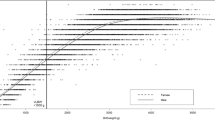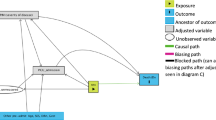Abstract
OBJECTIVES: To examine whether the improved survival of preterm infants has influenced the known male excess in infant mortality.
STUDY DESIGN: We analyzed sex-specific infant mortality using linked birth and death certificates for all 619,811 live born infants in Massachusetts between 1989 and 1995.
RESULTS: Between 1989 and 1995 the male excess in infant mortality decreased by 50%, from 1.6/1000 to 0.8/1000 live births (LB). This narrowing resulted primarily from a more rapid decline in neonatal mortality among male infants (1.5/1000 LB) than among female infants (0.9/1000 LB). The largest declines in the male excess in neonatal mortality occurred among very premature infants (GA ≤ 30 weeks) and resulted primarily from a more rapid decrease in male deaths from respiratory distress syndrome.
CONCLUSIONS: The narrowing of the sex difference in mortality between 1989 and 1995 suggests that newer treatments like antenatal steroids, and surfactants may have differentially benefited male infants.
This is a preview of subscription content, access via your institution
Access options
Subscribe to this journal
Receive 12 print issues and online access
$259.00 per year
only $21.58 per issue
Buy this article
- Purchase on Springer Link
- Instant access to full article PDF
Prices may be subject to local taxes which are calculated during checkout



Similar content being viewed by others
References
Naeye RL, Burt IS, Wright DI, et al. Neonatal mortality, the male disadvantage. Pediatrics 1971;48)6):902–906.
Khoury MJ, Marks JS, McCarthy BJ, et al. Factors affecting the sex differential in neonatal mortality. Am J Obstet Gynecol 1985;151(6):777–782.
Fanaroff AA, Wright LL, Stevenson DR, et al. Very low birth weight outcomes of the National Institute of Child Health and Human Development Neonatal Research Network, May 1991 through December 1992. Am J Obstet Gynecol. 1995;173(5):1423–1431.
Hammoud EI . Studies in fetal and infant mortality. Am J Public Health. 1965;55(8):1152–1163.
Chen SJ, Vohr BR, Oh W . Effects of birth order, gender, and IUGR on the outcome of VLBW in twins. J Pediatr. 1993;123(1):132–136.
Singh GK, Yu SM . Infant mortality in the US. Am J Public Health. 1995;85(7):957–964.
Hobar JD, Lucey J . Evaluation of neonatal intensive care technologies. In: The Future of Children, Vol. 5 (1): Low birth Weight, David and Lucille Packard Foundation, Los Altos, CA, 1995, p. 139–161.
NIH Consensus Development Panel. Effect of corticosteroids for fetal maturation on perinatal outcomes. JAMA 1995;273(5):413–417.
Palta M, Weinstein MR, McGuinness G, et al. A population study. Arch Pediatr Adolesc Med 1994;148:1295–1301.
Schoendorf KC, Kiely JL . Birth weight and age-specific analysis of the 1990 US infant mortality drop. Arch Pediatr Adolesc Med 1997;151(2):129–134.
Horbar JD, Wright E, Onstad L . Decreasing mortality associated with the introduction of surfactant therapy: an observational study of infants weighing 601 to 1300 grams at birth. Pediatrics 1993;92(2):191–196.
Spinillo A, Capuzzo E, Ometto A, et al. Value of antenatal corticosteroid therapy in preterm birth. Early Hum Dev 1995;42(1):37–47.
Crowley P, Chalmers I, Kierse MJ . The effects of corticosteroid administration before preterm delivery: an overview of the evidence from controlled trials. Br J Obstet Gynaecol. 1990;97:11–25.
Torday JS, Nielsen HC . The sex difference in fetal lung surfactant production. Exp Lung Res 1987;12:1–19.
Miller HC, Futrakul P . Birth weight, gestational age and sex as determining factors in the incidence of RDS of prematurely born infants. J Pediatr 1968;72(5):628–635.
David RJ . The quality and completeness of birthweight and gestational age data in computerized birth files. Am J Public Health 1980;70(9):964–973.
Alexander GR, Himes JH, Kaufman RB, et al. A United States national reference for fetal Growth. Obstet Gynecol 1996;87(2):163–168.
International Classification of Diseases. 9th Revision Clinical Modification: ICD-9-CM 4th ed. Vols. 1, 2, and 3 New York: McGraw-Hill; 1994.
National Center for Health Statistics. National Vital Statistics Reports Vol 47, No 23 Hyattsville, MD: National Center for Health Statistics; 1999.
National Center for Health Statistics. Monthly Vital Statistics Reports Vol 46, No (S)2 Hyattsville, MD: National Center for Health Statistics; 1997.
Hamvas A, Wise PH, Yang RK, et al. The influence of the wider use of surfactant therapy on neonatal mortality among Blacks and Whites. N Engl J Med 1996;334(25):1635–1640.
Kleinman JC, Fowler MG, Kessel SS . Comparison of infant mortality among twins and singletons: United States 1960 and 1983. Am J Epidemiol 1991;133(2):133–143.
Graybill FA, Iyer HK . Regression Analysis. Belmont, CA: Duxbury Press; 1994.
Jobe AH, Mitchell BR, Cunkel JH . Beneficial effects of the combined use of prenatal corticosteroids and postnatal surfactant on preterm infants. Am J Obstet Gynecol 1993;168:508–513.
Modanlou HD, Beharry K, Padilla G, et al. Combined effects of antenatal corticosteroids and surfactant supplementation on the outcome of very low birth weight infants. J Perinatol 1996;16(6):422–428.
Kleinman JC . Methodological issues in the analysis of vital statistics. In: Kiely M, editor. Reproductive and Perinatal Epidemiology. Boca Raton, FL: CRC Press; 1991.
National Center for Health Statistics. US Decennial Life Tables for 1989–91. Vol II, State Life Tables No 2. Massachusetts, Hyattsville, MD: National Center for Health Statistics; 1998.
Author information
Authors and Affiliations
Rights and permissions
About this article
Cite this article
Bhaumik, U., Aitken, I., Kawachi, I. et al. Narrowing of Sex Differences in Infant Mortality in Massachusetts. J Perinatol 24, 94–99 (2004). https://doi.org/10.1038/sj.jp.7211021
Published:
Issue Date:
DOI: https://doi.org/10.1038/sj.jp.7211021



